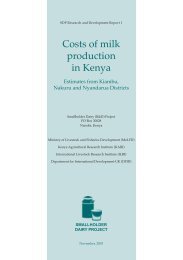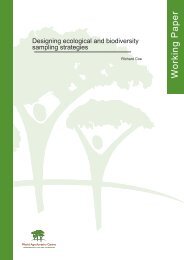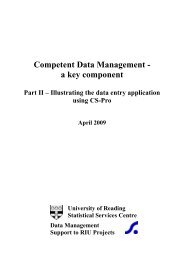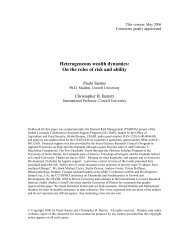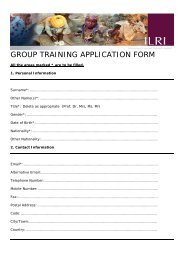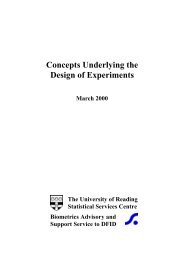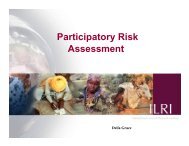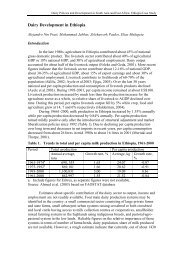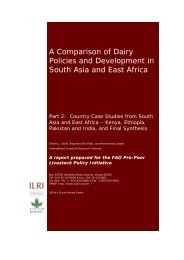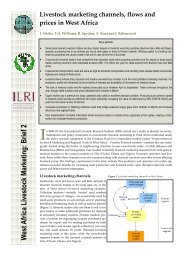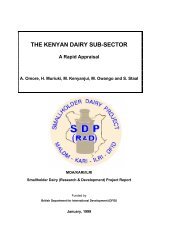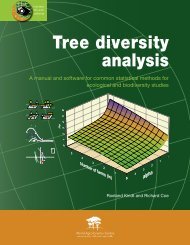Table A4. Cont<strong>in</strong>ued.Project TitleOn-farm crop–livestock farm<strong>in</strong>gsystem research on the utilisation<strong>of</strong> crop residues and other farmby-products on the growth andbreed<strong>in</strong>g performance <strong>of</strong> goats <strong>in</strong>uplands, Zamboanga City,M<strong>in</strong>danao island group (1987–90).Integration <strong>of</strong> forage productionwith cropp<strong>in</strong>g systems plus goats<strong>in</strong> uplands, Camar<strong>in</strong>es Sur, A87Luzon island group (1988–90).On-farm verification trial onliveweight ga<strong>in</strong> on goat fed oncrop residues with concentratesupplementation <strong>in</strong> uplands,Davao City, M<strong>in</strong>danao islandgroup (1992–93).SheepUtilisation <strong>of</strong> banana stalks, leavesand fodder tree leaves as feeds forgrow<strong>in</strong>g sheep,Leyte,Visayasisland group (Dates:NA).Response <strong>of</strong> sheep grazed onimproved/unimproved pasturewith concentrate supplementationunder coconut <strong>in</strong> uplands,M<strong>in</strong>danao island group (Dates:NA).Sw<strong>in</strong>eHog fatten<strong>in</strong>g us<strong>in</strong>g <strong>in</strong>digenousfeeds utilis<strong>in</strong>g rice bran as base,Surigao del Norte, M<strong>in</strong>danaoisland group (1987–89).Utilisation <strong>of</strong> cowpea for sw<strong>in</strong>e andpoultry production, Cavite andPangas<strong>in</strong>an, Luzon island group(Dates: NA).(Coconuts + p<strong>in</strong>eapple + taro) +sw<strong>in</strong>e fatten<strong>in</strong>g, Cavite, Luzonisland group (1988–90).PoultryIntegration <strong>of</strong> poultry <strong>in</strong> lowlandrice-based cropp<strong>in</strong>g pattern,Region 9, M<strong>in</strong>danao island group(1988–90).Rice–mungbean + native chicken<strong>in</strong> ra<strong>in</strong>fed lowland, Eastern Samar,Visayas island group (1989–91).<strong>Animal</strong>s andcrops producedGoats, riceand peanut.Goats, maize,Mango,Leucaena.Goats andmaize.Sheep,banana,Leucaena andGliricidia.Sheep andcoconut.Pigs and riceSheep,banana,Leucaena andGliricidia.Pigs, coconut,p<strong>in</strong>eapple andtaro.Chicken andrice.Chicken, riceand mungbean.Interventions testedImproved goatmanagement.Feed<strong>in</strong>g.Leucaena forage forgoats.Improved managementand concentratesupplementation.A: Banana stalk andleaves <strong>of</strong> Leucaena,concentrate.B: Banana stalks, leaves,Gliricidia.Plant<strong>in</strong>g <strong>of</strong> improvedgrass, concentratesupplementation.Improved feed<strong>in</strong>g,management.Estimated pr<strong>of</strong>itFarmerpractice/controlUS$ 421/yearFarmer:US$ 333US$ 366 after8 monthsExperimentalUS$ 883/yearSystem 1:US$ 914System 11:US$ 608US$ 546US$ 79 A: US$ 144B: US$ 87US$ 451/yearUS$ 32 at 8-months oldSupplements. NA NAImproved feed<strong>in</strong>g. NA NAFeed supplementation.Better managementpractice.US$ 611/yearUS$ 72US$ 890 US$ 1692Not clear. NA NA
Table A4. Cont<strong>in</strong>ued.Project TitleGoat and sheepSmall rum<strong>in</strong>ant/coconut systems <strong>in</strong>the uplands, Laguna, Luzon islandgroup (1991–93).Rice + backyard duck production <strong>in</strong>lowland irrigated area <strong>in</strong>Camar<strong>in</strong>es Sur, Luzon islandgroup (1991–92).Rice + duck–rice + duck <strong>in</strong> lowlandirrigated area, Luzon island group(1991–93).<strong>Animal</strong>s andcrops producedSheep andgoat, coconut.Interventions testedImproved Pasture.Improved animalmanagement.Estimated pr<strong>of</strong>itFarmerpractice/controlExperimentalDucks and rice. Technology verification. NA 30% higherthan controlDucks and rice. Technology verification.Integration <strong>of</strong> ducks.NANAUS$ 561. US$ 739Exchange Rate: Before 1990, US$ 1 = P15, after 1990, US$ 1 = P25 approximately.Government policies and regulationsTable A5 summarises the macro-economic and agricultural sector-specific policies currently <strong>in</strong> force and theirlikely impacts on the animal sub-sector, particularly <strong>in</strong> the smallholder mixed farm<strong>in</strong>g systems. However,empirical estimation <strong>of</strong> the impacts <strong>of</strong> these policies are not available. The effects <strong>of</strong> macro-economic policies,e.g.exchangeratetariffsandquotas, are <strong>in</strong>direct and havenot alwaysbeen addressedbyfarm<strong>in</strong>gsystemsresearchworkers (Paris and Sevilla 1995). However, it is essential to consider the sector-specific policy issues <strong>in</strong> design<strong>in</strong>gtechnology options and their test<strong>in</strong>g <strong>in</strong> real farm conditions, and the macro-economic issues <strong>in</strong> assess<strong>in</strong>g the realor socialbenefits<strong>of</strong> improved technologies. Asmentioned earlier, thedesignandeconomicevaluation <strong>of</strong> on-farmtechnology <strong>in</strong>terventions did not address these issues.ThailandEnvironment and cropp<strong>in</strong>g systemsFor the purposes <strong>of</strong> this study, primary emphasis is placed on north-east Thailand (latitude 14–19° North),<strong>in</strong> l<strong>in</strong>e with Thai Government policy for the future development <strong>of</strong> animal production <strong>in</strong> the country. This isone <strong>of</strong> the poorest regions with one-third <strong>of</strong> the human population <strong>of</strong> the country. Although the region ispredom<strong>in</strong>antly sub-humid, there may be small areas where the climate can be described as semi-arid. It is theleast productive region <strong>in</strong> the k<strong>in</strong>gdom (Wanapat 1995) and probably has similarities with eastern Indonesia,which was not visited. The region is a plateau (100–200 m altitude) with only 20% <strong>of</strong> the land suitable forirrigation. Approximately 7.0 million ha are used for rice production and the grow<strong>in</strong>g <strong>of</strong> upland field crops(mostly cassava, kenaf, maize and fruit), approximately 2.0 million ha are <strong>in</strong> forest and 5.5 million ha areunclassified. This contrasts with the other countries visited, where <strong>in</strong>tensive crop cultivation did not allowfor the presence <strong>of</strong> large areas for graz<strong>in</strong>g. The climate is tropical monsoonal with ra<strong>in</strong>fall averag<strong>in</strong>g 1200mm annually, and a dist<strong>in</strong>ct dry season from December to May, which has implications for animal feedavailability. Ra<strong>in</strong>fall distribution is a problem, with irregularities <strong>in</strong> the wet season that can affect crop growth.There is also variation <strong>in</strong> ra<strong>in</strong>fall between years. Soils are texturally sandy loams or loamy sands with lowlevels <strong>of</strong> fertility, low organic matter content and poor moisture-retention capacity which accentuates theeffects <strong>of</strong> the relatively low ra<strong>in</strong>fall. Erosion has been a problem on the sandy soils associated with theproduction <strong>of</strong> cassava. However, the area <strong>of</strong> cassava is now decl<strong>in</strong><strong>in</strong>g, and is be<strong>in</strong>g replaced by sugar-cane,which also <strong>of</strong>fers opportunities for animal feed.<strong>Crop</strong>p<strong>in</strong>g patterns are not as diverse as <strong>in</strong> the other countries visited, which is probably related to ra<strong>in</strong>fall.The dom<strong>in</strong>ant crop is rice, with both irrigated and ra<strong>in</strong>fed varieties be<strong>in</strong>g planted. In many situations, no
- Page 2 and 3:
Affiliation of Authors:Dr C. Devend
- Page 4 and 5:
6.Strategyfor researchJustification
- Page 7 and 8:
AcknowledgementsThe International L
- Page 9 and 10:
esearch opportunities appropriate t
- Page 11 and 12:
Table 1.Animal populations and meat
- Page 13 and 14:
Introduction2. Characterisation and
- Page 15 and 16:
Figure 2. Sub-humid tropics and sub
- Page 17 and 18:
Table 3.Human and animal population
- Page 19 and 20:
Table 5. Rice-growing environments
- Page 21 and 22:
Multiple upland annual crop systems
- Page 23 and 24:
Table 6. Continued.Country Importan
- Page 25 and 26:
It should be noted that, compared w
- Page 27 and 28:
Table 8.CountryCambodiaChinaIndones
- Page 29 and 30:
of non-renewable fossil fuels and t
- Page 31 and 32:
Overview of researchThere was a sur
- Page 33 and 34:
• Identification of alternative c
- Page 35 and 36:
Various animal production systems t
- Page 37 and 38: Presently, much of the vegetable pr
- Page 39 and 40: Table 10. Summary of the main socio
- Page 41 and 42: Table 11. Institutions and organisa
- Page 43 and 44: 3. In the ASEAN sub-region, inadequ
- Page 45 and 46: Table 12. Continued.SituationsPract
- Page 47 and 48: 6. Strategy for researchJustificati
- Page 49 and 50: Table 13. Priorities for research a
- Page 51 and 52: VietnamResearch capacity in NARS is
- Page 53 and 54: CRIFC (Central Research Institute f
- Page 55 and 56: IAS. 1995. Proceedings of the Works
- Page 57 and 58: Systems of sub-Saharan Africa. Volu
- Page 59 and 60: or waterlogged in the wet season an
- Page 61 and 62: Table A1. Important diseases of ani
- Page 63 and 64: • Increased cropping intensities,
- Page 65 and 66: the animal output came from pigs al
- Page 67 and 68: 18-21° North, with an average rain
- Page 69 and 70: In the Nusa Tenggara islands, signi
- Page 71 and 72: Women work 11.5 h/day on average co
- Page 73 and 74: Various Australian forage projects
- Page 75 and 76: village production systems; to stud
- Page 77 and 78: The availability of feed in rubber
- Page 79 and 80: of the Ayeyarwady and Sittang river
- Page 81 and 82: Constraints and opportunitiesInadeq
- Page 83 and 84: gaining in importance, and signific
- Page 85 and 86: Table A3. Characterisation of crop-
- Page 87: Table A4. Interventions in crop-ani
- Page 91 and 92: otations are practised, and there a
- Page 93 and 94: such as abortion. Vaccination cover
- Page 95 and 96: large areas of forests (3.4 million
- Page 97 and 98: Table A6. Some animal diseases repo
- Page 99 and 100: Appendix IIItineraryThe Philippines
- Page 101 and 102: 26 November 1996 am Visit to small
- Page 103 and 104: Appendix IIIList of persons metPhil
- Page 105 and 106: Mr Chhiv Nan, Acting Director, Depa
- Page 107 and 108: Dr U Maung Ngint, Managing Director
- Page 109: List of acronymsAARDACIARADBAEZAIBP



